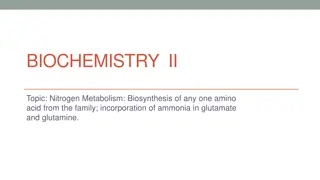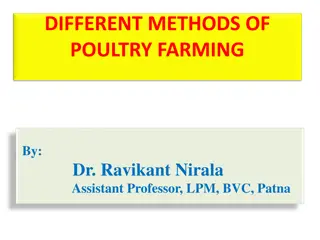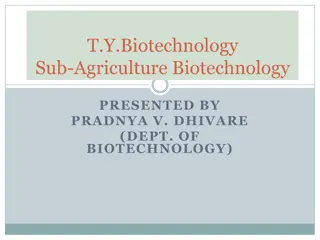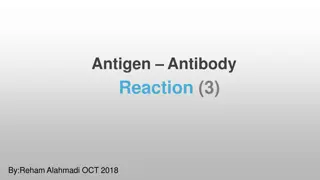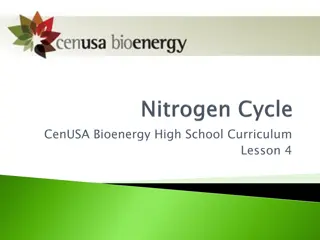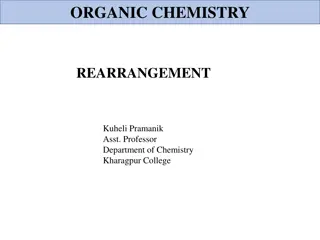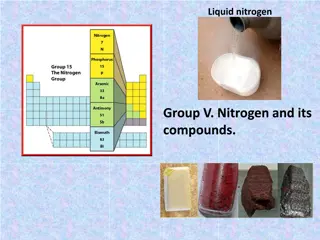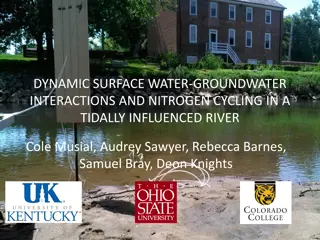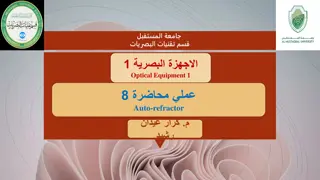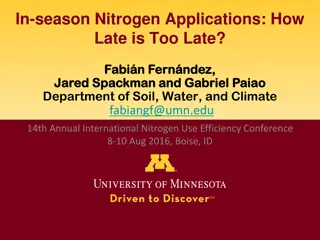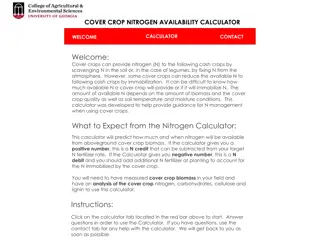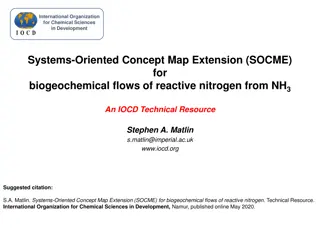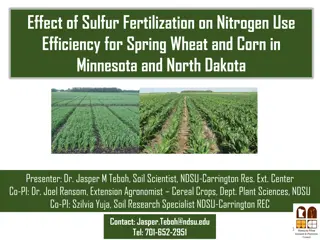
Nitrogen and Its Role in Plant Growth
Explore the significance of nitrogen fixation, sources of nitrogen, and the critical role nitrogen plays in plant development. Learn about biological and non-biological nitrogen fixation processes, as well as the various types of microorganisms involved in nitrogen fixation.
Download Presentation

Please find below an Image/Link to download the presentation.
The content on the website is provided AS IS for your information and personal use only. It may not be sold, licensed, or shared on other websites without obtaining consent from the author. If you encounter any issues during the download, it is possible that the publisher has removed the file from their server.
You are allowed to download the files provided on this website for personal or commercial use, subject to the condition that they are used lawfully. All files are the property of their respective owners.
The content on the website is provided AS IS for your information and personal use only. It may not be sold, licensed, or shared on other websites without obtaining consent from the author.
E N D
Presentation Transcript
Nitrogen Fixation Nitrogen Fixation
Role of Nitrogen in Plants Role of Nitrogen in Plants Major substance in plants next to water Building blocks Constituent element of Chlorophyll Cytochromes Alkaloids Many vitamins Plays important role in metabolism, growth, reproduction and heredity
Sources of Nitrogen Sources of Nitrogen Atmospheric Nitrogen 78% of atmosphere Plants cannot utilize this form Some Bacteria, Blue Green Algae, leguminous plants Nitrates, Nitrites and Ammonia Nitrate is chief form Amino acids in the soil Many soil organisms use this form Organic Nitrogenous compounds in insects Insectivorous plants
Nitrogen fixation Nitrogen fixation The conversion of free nitrogen into nitrogenous salts to make it available for absorption of plants.
Types of Nitrogen Fixation Types of Nitrogen Fixation Nitrogen fixation Biological Non biological Non - symbiotic Symbiotic
Non Biological Fixation Non Biological Fixation The micro-organisms do not take place Found in rainy season during lightning 1. N2+ O2 2 NO lightning (Nitric oxide) 2NO2 ( Nitrogen per oxide) 2. 2NO + O2 oxidation 3. 2NO2+ H2O HNO2+ HNO3 4. 4NO2+ 2H2O + O2 4HNO3 (Nitric acid) 5. HNO3+ NH3 NH4NO3 (Ammonium nitrate) NH4NO2 (Ammonium nitrite) 6. HNO2+ NH3
Biological fixation Biological fixation Fixation of atmospheric Nitrogen into nitrogenous salts with the help of micro-organisms. Two types Symbiotic Non-symbiotic
Non Non- -symbiotic symbiotic o Fixation carried out by free living micro-organisms o Aerobic, anaerobic and blue green algae o Bacteria: special type (nitrogen fixing bacteria) types - o Free living aerobic : Azotobacter, Beijerenckia o Free living anaerobic : Clostridium o Free living photosynthetic : Chlorobium, Rhodopseudomonas o Free living chemosynthetic :Desulfovibro,Thiobacillus
Contd.. Contd.. o Free living fungi: yeasts and Pillularia o Blue green algae: o unicellular Gloeothece, Synechococcus o Filamentous (non heterocystous) -Oscillatoria o Filamentous (heterocystous) Tolypothrix, Nostoc, Anabaena
Symbiotic Symbiotic Fixation of free nitrogen by micro-organisms in soil living symbiotically inside the plants Symbiosis coined by DeBary Three categories Nodule formation in leguminous plants Nodule formation in non-leguminous plants Non nodulation
Nodule Formation In Leguminous Nodule Formation In Leguminous Plants Plants 2500 spp. Of family leguminosae ( Cicer arientium, Pisum, Cajanus, Arachis) produce root nodules with Rhizobium spp. They fix Nitrogen only inside the root nodules Association provides-food and shelter to bacteria-bacteria supply fixed nitrogen to plant.
Nodule formation in non Nodule formation in non- -leguminous plants plants leguminous Some other plants also produces root nodules Causuarina equisetifolia Frankia Alnus Frankia Myrica gale Frankia Parasponia Rhizobium Leaf nodules are also noted Dioscorea, Psychotria Gymnosperms root Podocarpus, -leaves Pavetta zinumermanniana, Chomelia
Non Non- -nodulation nodulation Lichens - cyanobacteria Anthoceros - Nostoc Azolla Anabaena azollae Cycas Nostoc and anabaene Gunnera macrophylla - Nostoc Digitaria, Maize and Sorghum Spirillum notatum Paspalum notatum Azotobacter paspali
Symbiotic nitrogen fixation Symbiotic nitrogen fixation Small, knob-like protuberances-root nodules Size and shape varies Spherical, flat, finger-like or elongated From Pin head to one centimeter in size Various spp. Of Rhizobium noted Named after the host plant Pea Rhizobium leguminosarum Beans R. phaseoli Soyabeans R. japonicum Lupins R. lupini Two types of Rhizobium- Bradyrhizobium slow growing spp. Rhizobium - fast growing spp.
Formation Of Root Nodules In Legumes Formation Of Root Nodules In Legumes Root nodules formed due to infection of Rhizobium Free living bacteria growing near root of legumes unable to fix nitrogen in free condition Roots of the legumes secrete some growth factors helps in fast multiplication of bacteria (E.g.) Pisum sativum secretes homo serine also carbohydrate containing protein Lectins over their surface
Contd.. Contd.. This helps in recognition and attachment of rhizobial cells Rhizobial cells have carbohydrate receptor on their surface Lectins interact with the carbohydrate receptor of rhizobial cells Bacteria enter the roots through soft infected root hairs Tips are deformed and curved Tubular infection thread is formed in the root hair cell and bacteria enters into it
Contd.. Contd.. After entry, new cell wall is formed Tubular infection contains mucopolysaccharides where bacteria embedded and start multiplication It grows much and reaches the inner layers of cortex and the bacteria is released It induces the cortical cells to multiply which result in the formation of nodule on the surface
Structure and function of nodule Structure and function of nodule Rate of N- fixation of nodule directly proportional to the volume of the nodule. Nodules are small-contain leghaemoglobin Leghaemoglobin Effective nodules are larger- pink in colour -due to the presence of red coloured leghaemoglobin. This pigment is similar to haemoglobin of blood. Found in nodules between bacteriods & membrane envelops, enclosing them.
Contd.. Contd.. After host cells are completely filled,bacterial cells becomes dormant-bacteroids Float in leghaemoglobin Pinkish pigment in cytoplasm of host cells - Efficient O2scavenger - Maintains steady state of oxygen - Stimulates ATP production
Biochemistry of nitrogen fixation Biochemistry of nitrogen fixation Basic requirements for Nitrogen fixation Nitrogenase and hydrogenase enzyme Protective mechanism against Oxygen Ferrodoxin Hydrogen releasing system or electron donor (Pyruvic acid or glucose/sucrose) Constant supply of ATP Coenzymes and cofactors TPP, CoA, inorganic phosphate and Mg+2 Cobalt and Molybdenum A carbon compound
Nitrogenase enzyme Plays key role Active in anaerobic condition Made up of two protein subunits Non heme iron protein ( Fe-protein or dinitrogen reductase) Iron molybdenum protein (Mo Fe-protein or dinitrogenase) Fe protein reacts with ATP and reduces second subunit N2+ 8H+ + 8e- 2NH3+ H2
Genes involved in Nitrogen fixation Genes involved in Nitrogen fixation Genes involved in root nodule formation - called nodulin genes ( nod genes) Nodulin genes essential for infection of plant root and nodule formation by symbiotic N fixing bacteria - divided into 2 classes 1) include genes that specify biochemical composition of bacterial cell surface. such as gene determining the synthesis of exopolysaccharides ( exo genes) Lipopolysaccharides (lps gene) Capsular polysaccharides or K antigen & 1,2 glucans (ndu genes)
exo & lps genes - play a role in determining host specificity 2) consist of nodulation genes (nod or nol) nod genes are involved in nodulation of particular host -called host specific nod(hsn) genes.
nif and fix genes - structural genes for nitrogenase enzyme Sym plasmid carry hup genes coding for hydrogenase activity Nif genes - 22 genes are involved , arranged in 7/8clusters .
CONCLUSION CONCLUSION Nitrogen is very important component of the living organisms on earth. As it is a constituent of amino acids, proteins, DNA and other macromolecules acts as a building block of all the cellular and molecular processes. But most of the nitrogen available in the atmosphere is found in free form ,only certain bacterial species and by using some chemical methods it can be converted into absorbable form. A lot of research is going on biological nitrogen fixation and exhaustive approach is required to increase the process of nitrogen fixation. an
REFERENCES REFERENCES Hopkins G. William, Huner, A.P. Norman (2009). Introduction to Plant Physiology, 4th Edn. pp. 195-209. John Wiley and Sons, USA. Taiz L.,Zeiger,E.(2010).Plant Physiology,5thEdn.pp 351-357. SinauerAssociates Inc.,Sunderland,Massachusets,USA.




